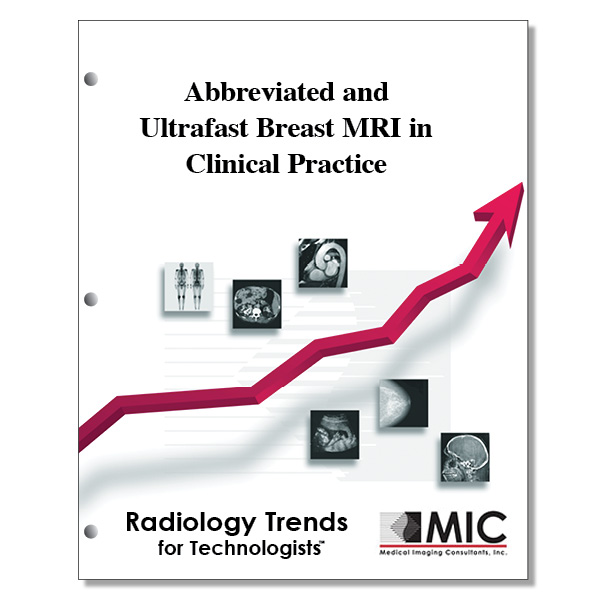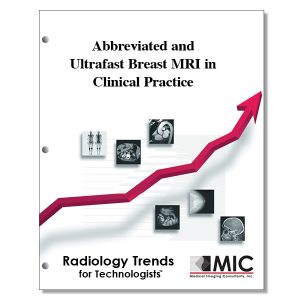

Abbreviated and Ultrafast Breast MRI in Clinical Practice
Abbreviating the MRI exam may make it more available to a larger audience and expand the role of MRI in breast cancer screening. Current techniques, diagnostic criteria, advantages and pitfalls are presented.
Course ID: Q00662 Category: Radiology Trends for Technologists Modalities: Mammography, MRI2.5 |
Satisfaction Guarantee |
$29.00
- Targeted CE
- Outline
- Objectives
Targeted CE per ARRT’s Discipline, Category, and Subcategory classification:
[Note: Discipline-specific Targeted CE credits may be less than the total Category A credits approved for this course.]
Breast Sonography: 1.00
Patient Care: 1.00
Patient Interactions and Management: 1.00
Mammography: 1.00
Procedures: 1.00
Mammographic Positioning, Special Needs, and Imaging Procedures: 1.00
Magnetic Resonance Imaging: 2.00
Image Production: 0.50
Sequence Parameters and Options: 0.25
Data Acquisition, Processing, and Storage: 0.25
Procedures: 1.50
Body: 1.50
Registered Radiologist Assistant: 1.00
Procedures: 1.00
Thoracic Section: 1.00
Radiation Therapy: 1.00
Patient Care: 1.00
Patient and Medical Record Management: 1.00
Outline
- Introduction
- The Basics
- Structural versus Functional Imaging
- Basic Terminology
- Abridged MRI Techniques
- Abbreviated MRI
- Ultrafast MRI
- Newer Terminology
- Existing Challenge and Potential Solution
- Abridged MRI: Advantages
- Lesion Conspicuity
- Functional Depiction
- Discriminating Power
- Abridged MRI: Disadvantages
- Spatial Resolution
- Loss of Sensitivity
- Benign Cofounders
- Clinical Indications
- High-Risk Screening
- Average-Risk Screening
- Caveats
- Other Considerations
- Conclusion
Objectives
Upon completion of this course, students will:
- know how abbreviated and ultrafast breast MRI compare to full protocol contrast-enhanced breast MRI
- define functional imaging
- understand the difference between structural and functional imaging
- realize what causes limits to mammography’s sensitivity
- know the type of cancer dynamic contrast-enhanced MRI tends to identify
- state the attributes of ultrafast MRI
- define spatial resolution
- define temporal resolution
- recognize tumor enhancement characteristics
- realize characteristics of abbreviated breast MRI
- identify approaches used to attain high temporal resolution
- compare enhancement characteristics of malignant and benign breast lesions
- pinpoint a limitation of full protocol dynamic contrast-enhanced breast MRI
- know what early reader studies have shown regarding ultrafast breast MRI
- recognize the tradeoffs in ultrafast MRI
- recall the type of postprocessed images from abridged MRI that allow for quick interpretation while maintaining a high negative predictive value
- realize what you don’t see by eliminating the later postcontrast sequences in abbreviated MRI
- know the principles of contrast-enhanced MRI and the functional depiction of tumor vascularity
- define neoangiogenesis
- know what type of breast imaging evaluation ultrafast MRI is best suited to
- know statistics of the high risk population for breast cancer
- recall recommended breast exams for average breast cancer risk individuals
- define diffusion-weighted MRI
- know what conditions must be met for a breast MRI exam to be billable
